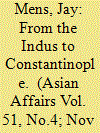| Srl | Item |
| 1 |
ID:
148021


|
|
|
|
|
| Summary/Abstract |
In the imaginations of many, war in British India had its focus on the North-West Frontier and was fought against the tribes of that region. However, British thinking about Indian defence involving Afghanistan underwent tremendous change over the period under consideration. British plans to meet a Russian invasion on the Kabul-Kandahar Line in 1904 resembled those of any other Nineteenth Century Imperial campaign, with numbers of infantry and cavalry still being thought of and referred to as bayonets and sabres. Twenty years later, heavily influenced by the experiences of the Great War in the region and the Third Afghan War and associated operations, the calculus was different with logistics changed by motor vehicles and the introduction of what today are referred to as force multipliers, such as aeroplanes and machine guns. It was over this period that warfare as fought and conceptualised by men like Napoleon gave way to modern practices familiar to us today.
|
|
|
|
|
|
|
|
|
|
|
|
|
|
|
|
| 2 |
ID:
182831


|
|
|
|
|
| Summary/Abstract |
This article argues that Napoleon Bonaparte's attempt to reach India, firstly through Egypt and then through Qajar Persia, inaugurated the ‘Middle East' as a coherent political space in international politics. The ostensibly existential threat posed by French schemes to British dominion over India prompted British Indian officials to perceive Egypt, Persia and the Gulf Emirates through the lens of Indian defence and European geopolitics for the first time. By the end of this period, these lands were imagined as a salient, somewhat coherent political space between “the Indus and Constantinople”. This first ‘Middle East’ was the product of the globalization of European geopolitics and the need to defend British India, auguring the future of the region, in which its political importance, and even its location, was constructed in relation to the broader context of international affairs.
|
|
|
|
|
|
|
|
|
|
|
|
|
|
|
|